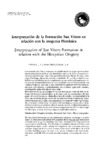Mostrar o rexistro simple do ítem
Interpretación de la Formación San Vitero en relación con la orogenia Hercínica
| dc.contributor.author | Antona, J. F. | |
| dc.contributor.author | Martínez Catalán, J. R. | |
| dc.date.accessioned | 2010-01-22T13:18:11Z | |
| dc.date.available | 2010-01-22T13:18:11Z | |
| dc.date.issued | 1990 | |
| dc.identifier.citation | Cadernos do Laboratorio Xeolóxico de Laxe, 1990, 15: 257-269 ISSN: 0213-4497 | es_ES |
| dc.identifier.issn | 0213-4497 | |
| dc.identifier.uri | http://hdl.handle.net/2183/6069 | |
| dc.description.abstract | [Resumen] La Formación San Vitero constituye un amplio tramo en el que aparecen alternancias grauváquico-pelíticas, con abundantes cambios de facies y frecuentes estructuras sedimentarias, tales como granoclasificaciones, figuras de carga, «convoluted bedding», figuras de corriente e icnofósiles. Se trata de un depósito turbidítico con abundantes niveles conglomeráticos, que incluyen fragmentos de rocas con una esquistosidad previa y restos de plantas que no han permitido una clasificaci6n precisa. En toda la zona Centroibérica aparecen unos materiales semejantes a los descritos y probablemente con el mismo significado tectónico, constituyendo todas ellas típicas series culm. Se ha encontrado que esta formación ha sido afectada por todas las fases de deformación Hercínica identificables en la zona y por un metamorfismo de bajo grado, dentro de la epizona, deducido a partir de estudios de cristalinidad de la illita, que no difiere del que afectó a los materiales silúricos infrayacentes. Consideraciones acerca de su edad, por comparación con series del mismo tipo localizadas en la zona Centroibérica, y los datos sedimentológicos, estructurales y metamórficos mencionados permiten deducir que se trata de un flysch sinorogénico, cuya edad coincidiría con los movimientos correspondientes al inicio de la orogenia Hercínica, es decir, Devónico Superior -Carbonífero Inferior. | |
| dc.description.abstract | [Abstract] The San Vitero Formation is a thick sedimentary sequence consisting in an alternation of greywackes and pelites with abundant facies changes and sedimentary structures such as graded bedding, load casts, convoluted bedding and scour casts as well as ichnofossiles. The formation is a turbiditic deposit with abundant conglomerate layers, which include rock fragments with a previous schistosity and plant fragments that have not allowed precise classification. Materials similar to those described appear in sorne other places throughout the Central-Iberian Zone, probably with the same tectonic meaning,-constituting the culm senes. It has been found that the formation has been affected by aH of the Hercinian deformation phases in the area, and by a low grade metamorphism (epizone), deduced from studies of iHite crystaHinity, which do not differs from the one that affected the underlying silurian materials. Considerations relative to the age of the formation, by correlation with series of the same type in the Central-Iberian Zone, and the mentioned sedimentary, structural and metamorphic data, point to the conclusion that this formation is a synorogenic fiysch, whose age coincides with that of the beginning of the Hercynian Orogeny, that is, Upper Devonian-Lower Carboniferous. | |
| dc.language.iso | spa | es_ES |
| dc.publisher | Universidade da Coruña | es_ES |
| dc.subject | Orogenia Hercínica | es_ES |
| dc.subject | Formación de San Vitero | es_ES |
| dc.subject | Flysch sinorogénico | es_ES |
| dc.subject | Hercynian orogeny | es_ES |
| dc.subject | San Vitero formation | es_ES |
| dc.subject | Sinorogenic flysch | es_ES |
| dc.title | Interpretación de la Formación San Vitero en relación con la orogenia Hercínica | es_ES |
| dc.title.alternative | Interpretation of San Vitero Formation in relation with the Hercynian Orogeny | |
| dc.type | info:eu-repo/semantics/article | es_ES |
| dc.rights.access | info:eu-repo/semantics/openAccess |






